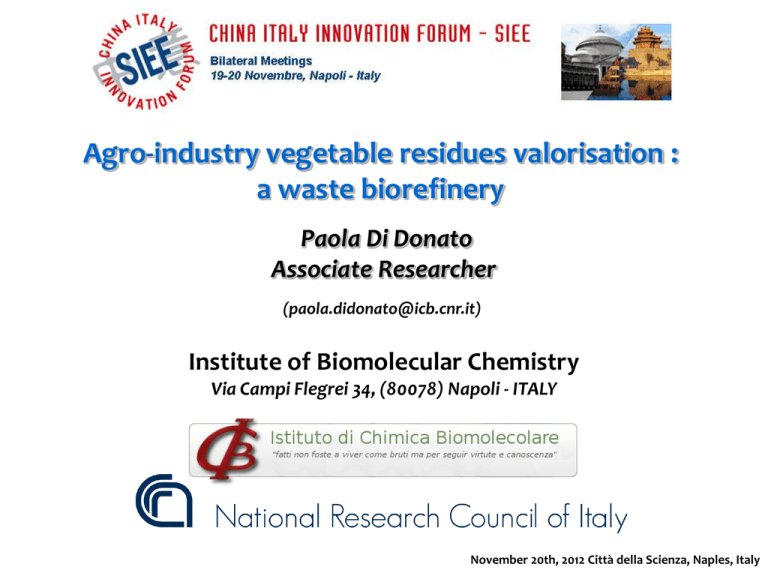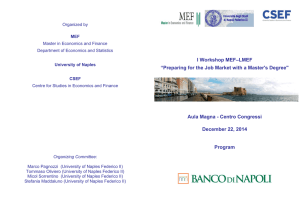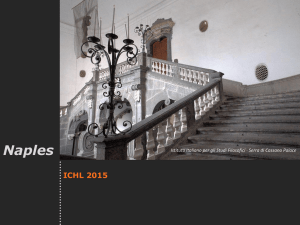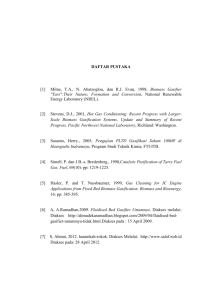Agro-industry vegetable residues valorisation :a waste biorefinery
advertisement

Agro-industry vegetable residues valorisation : a waste biorefinery Paola Di Donato Associate Researcher (paola.didonato@icb.cnr.it) Institute of Biomolecular Chemistry Via Campi Flegrei 34, (80078) Napoli - ITALY November 20th, 2012 Città della Scienza, Naples, Italy Padova 31 institutes Institute of Biomolecular Chemistry Pozzuoli, Napoli 45 institutes Rome Sassari Naples 31 institutes Catania November 20th, 2012 Città della Scienza, Naples, Italy •Born in 1967 as “Istituto per la Chimica e Fisica delle Molecole di Interesse Biologico” (ICMIB), “Institute for the Chemistry and Physics of Biologically Interesting Molecules”. • In 2002 it moved to the new building in Pozzuoli (NA) and took the name of “Istituto di Chimica Biomolecolare (ICB-CNR)”. Institute of Biomolecular Chemistry that today includes also the Roma, Catania, Sassari and Padova branches. • Main research activities in ICB are in the fields of organic chemistry, biochemistry and microbiology with main topics including environmental, pharmaceutical, food and biotechnological applications. November 20th, 2012 Città della Scienza, Naples, Italy Agro-industry residues: a waste biomass According the Directive 2001/77/EC of the European Community biomass is “the biodegradable fraction of products, waste and residues from agriculture (including vegetal and animal substances), forestry and related industries, as well as the biodegradable fraction of industrial and municipal waste” Source: http://www.ecomena.org/biomass-resources-in-middle-east/ November 20th, 2012 Città della Scienza, Naples, Italy Residual biomass: yearly production in Italy BIOMASS QUANTITY Animal residues 150.000.000 t/y Agro-industrial wastes 12.000.000 t/y Slaughter wastes 1.000.000 t/y Sewage sludges 3.000.000 t/y Municipal wastes (organic fraction) 9.000.000 t/y Forestry and crop residues 10.000.000 t/y (source: C.R.P.A., Animal Production Research Centre, Italy) November 20th, 2012 Città della Scienza, Naples, Italy Agro-industry residual biomass in Italy: yearly amounts Biomass available (thousand tons/year) Actual re-use strategy Wood transformation 4.400 Energy production Wood recycling 8.000 Energy production Paper Industry 270 Energy production Food Oil 450 Energy, composting Winery 450 Energy, composting Canning and market packaging 340 Energy, composting Rice transformation 330 Energy, composting Industry (source: Itabia ) November 20th, 2012 Città della Scienza, Naples, Italy Agro-industry residual biomass: a resource that can be valorised Environmental problem Economical issue …. but a significant fraction of biomolecules is lost after industrial processing, being discarded into the residual matter….. proteins, fibres, polysaccharides, sugars, polyphenols, carotenoids drugs nutraceuticals cosmetics biopolymers biofuels by-products that can represent the starting material for other processes raw materials not in competition with food chain November 20th, 2012 Città della Scienza, Naples, Italy Agro-industry residual biomass: a resource that can be valorised The biorefinery approach • Food industry wastes BIOMASS Transformation technologies Energy and chemicals (vegetables processing residues) • Agriculture and crop residues •Bioprocesses (bacteria, enzymes) •Chemical Processes •Physical Processes •Biofuels •Antioxidants •Biopolymers Adapted from Kamm, B.; Kamm, M. (2004). Principles of Biorefineries. Appl. Microbiol. Biotechnol. (AMB), 64: 137-145. November 20th, 2012 Città della Scienza, Naples, Italy Agro-industry wastes biorefinery: ongoing research at the Institute of Biomolecular Chemistry Crop production Industry Waste fraction Tomato (Lycopersicon esculentum) 5.125.000 t/y Canning for juice and paste 1,8-2,3 % (peels, seeds, immature and damaged fruits) Lemon (Citrus limon) 488.000 t/y Liquor production 60 % (peels, pulps) Carrot (Daucus carota) 630.000 t/y Packing for whole sale market; juices production 30-40 % (immature or damaged fruits) Fennel (Foeniculum vulgare var. Dulce) 600.000 t/y Packing for whole sale market 40 % (leaves, damaged fruits) dry waste gross composition Tomato Lemon Carrot Fennel Data from INRAN (Istituto Nazionale di Ricerca per gli Alimenti e la Nutrizione) November 20th, 2012 Città della Scienza, Naples, Italy Agro-industry wastes biorefinery: ongoing research at the Institute of Biomolecular Chemistry Polysaccharides recovery II generation bioethanol Antioxidants recovery November 20th, 2012 Città della Scienza, Naples, Italy Isolation of tomato’s wastes polysaccharides Tomato waste peels Chemical and physical characterization of isolated polysaccharides Alkali treatment at r.t. MW (Da)>1.000.000; High viscosity; High thermal resistance; [a]D25-0,189.0 Polysaccharide Glc/Xil/Gal/GalN/GlcN/Fuc (1:0.9:0.5:0.4:0.2:tr) •Collaboration with Dr. Mario Malinconico and Dr. Barbara Immirzi (ICTP – CNR) Container and object construction Innovative material for containers or for green house applications November 20th, 2012 Città della Scienza, Naples, Italy Isolation of tomato’s wastes polysaccharides biotechnological applications Tomato waste peels Alkali treatment at r.t. Biodegradable film for solarization or mulching applications •Collaboration with Dr. Mario Malinconico and Dr. Barbara Immirzi (ICTP – CNR) Polysaccharide biological properties Inhibition of NF-kB/DNA binding activity Incorrect regulation of NF-κB has been linked to cancer, inflammatory and autoimmune diseases, et cetera November 20th, 2012 Città della Scienza, Naples, Italy vegetable wastes polysaccharides extraction: ongoing research fennel residues lemon wastes (pomace) alkali/acid extraction •Structural analysis (MW; monomer composition; spectroscopic analysis) •Thermogravimetrical analysis carrot residues •Maceration •Ultrasound assisted •Microwaves assisted POLYSACCHARIDES Biotechnological applications Biological properties November 20th, 2012 Città della Scienza, Naples, Italy Agro-industry wastes biorefinery: ongoing research at the Institute of Biomolecular Chemistry Polysaccharides recovery II generation bioethanol Antioxidants recovery November 20th, 2012 Città della Scienza, Naples, Italy vegetable wastes polyphenols extraction: ongoing research fennel residues lemon wastes (pomace) MeOH; EtOH; MeOH/H2O; EtOH/H2O •Structural analysis •Antioxidant and radical scavenging activities •Biological activity assay carrot residues tomato residues •Maceration •Ultrasound assisted •Microwaves assisted POLYPHENOLS Biotechnological applications Biological properties November 20th, 2012 Città della Scienza, Naples, Italy Vegetable wastes polyphenols extraction work in progress….. Project PON01_01966 Integrated agro-industrial chains with high energy efficiency for the development of eco-compatible processes of energy and biochemicals production from renewable sources and for the land valorisation (EnerbioChem) Naples University “Federico II” November 20th, 2012 Città della Scienza, Naples, Italy Agro-industry wastes biorefinery: ongoing research at the Institute of Biomolecular Chemistry Polysaccharides recovery II generation bioethanol Antioxidants recovery November 20th, 2012 Città della Scienza, Naples, Italy Agro-industry wastes: production of enzymes for second generation bioethanol from extremophiles Bilateral Project Italy-Turkey “Extremophiles for Next-Generation Biofuels ” Dr. Barbara Nicolaus Prof. Ebru Toksoy Oner •Vegetable wastes under investigation: potato peels, carrot, tomato, sugar beet pulp, starch and sugar beet molasses November 20th, 2012 Città della Scienza, Naples, Italy Agro-industry wastes: production of second generation bioethanol I generation bioethanol Starch (energy crops) T = 90100°C II generation bioethanol Waste Biomass* liquefaction by thermostable amylases (starch cooking) Simultaneous Saccharification and Fermentation dextrins T= 65°C saccharification by thermostable amylases glucose Starch degradation and sugar Fermentation by engineered yeasts: expression of raw starch degrading enzymes in Saccharomyces spp glucose T= 45°C Yeasts Fermentation (Saccharomyces spp) CH3CH2OH CH3CH2OH * Not in competition with food chain November 20th, 2012 Città della Scienza, Naples, Italy Agro-industry wastes: production of enzymes for second generation bioethanol from extremophiles Amylolytic thermophile Agro-industry wastes as culture media for extremophiles’ fermentation Geobacillus thermoleovorans (strain PIZZOT) dry cell weight (mg) 500 synthetic media lemon 400 tomato 300 200 100 (starch digestion to glucose without cooking pre-treatment) Optical microscopy observation of raw starch before (a) and after (b) digestion by G. thermoleovorans amylase tomato fennel F F1 B D F D F F F1 D B D F1 F D B F D F F1 B lemon D F D M +G a D M l +T D re M +M al raw starch degrading amylase D C M 0 carrot wastes as culture media for amylase production Complex medium Lemon medium 16.25 U/mg protein 6.375 U/mg protein Di Donato P., G. Fiorentino G., Anzelmo G., Tommonaro G., Nicolaus B., Poli A. 2011 “Waste Biomass Valorization” 2: 103-111 November 20th, 2012 Città della Scienza, Naples, Italy In conclusion….. by means of an integrated biorefinery approach waste biomass from agro-industry can be valorised to give Fibers and polysaccharides for biodegradable polymers production Biomolecules for several applications: antioxidants and bioactive molecules for pharmaceutical, cosmetic or food applications Microorganisms and enzymes for second generation biofuels production November 20th, 2012 Città della Scienza, Naples, Italy Thanks to…. Dott. Barbara Nicolaus Dott. Annarita Poli Dott. Licia Lama Dott. Giuseppina Tommonaro Prof. Ebru Toksoy Oner “If you want to go fast, go alone. If you want to go far, go together” African proverb November 20th, 2012 Città della Scienza, Naples, Italy Thanks for your attention! Dott. Paola Di Donato paola.didonato@icb.cnr.it paola.didonato@uniparthenope.it Grönlund-Nisunen - Wave of Matter 2012


